
- 阻害剤
- 研究分野別
- PI3K/Akt/mTOR
- Epigenetics
- Methylation
- Immunology & Inflammation
- Protein Tyrosine Kinase
- Angiogenesis
- Apoptosis
- Autophagy
- ER stress & UPR
- JAK/STAT
- MAPK
- Cytoskeletal Signaling
- Cell Cycle
- TGF-beta/Smad
- 化合物ライブラリー
- Popular Compound Libraries
- Customize Library
- Clinical and FDA-approved Related
- Bioactive Compound Libraries
- Inhibitor Related
- Natural Product Related
- Metabolism Related
- Cell Death Related
- By Signaling Pathway
- By Disease
- Anti-infection and Antiviral Related
- Neuronal and Immunology Related
- Fragment and Covalent Related
- FDA-approved Drug Library
- FDA-approved & Passed Phase I Drug Library
- Preclinical/Clinical Compound Library
- Bioactive Compound Library-I
- Bioactive Compound Library-II
- Kinase Inhibitor Library
- Express-Pick Library
- Natural Product Library
- Human Endogenous Metabolite Compound Library
- Alkaloid Compound LibraryNew
- Angiogenesis Related compound Library
- Anti-Aging Compound Library
- Anti-alzheimer Disease Compound Library
- Antibiotics compound Library
- Anti-cancer Compound Library
- Anti-cancer Compound Library-Ⅱ
- Anti-cancer Metabolism Compound Library
- Anti-Cardiovascular Disease Compound Library
- Anti-diabetic Compound Library
- Anti-infection Compound Library
- Antioxidant Compound Library
- Anti-parasitic Compound Library
- Antiviral Compound Library
- Apoptosis Compound Library
- Autophagy Compound Library
- Calcium Channel Blocker LibraryNew
- Cambridge Cancer Compound Library
- Carbohydrate Metabolism Compound LibraryNew
- Cell Cycle compound library
- CNS-Penetrant Compound Library
- Covalent Inhibitor Library
- Cytokine Inhibitor LibraryNew
- Cytoskeletal Signaling Pathway Compound Library
- DNA Damage/DNA Repair compound Library
- Drug-like Compound Library
- Endoplasmic Reticulum Stress Compound Library
- Epigenetics Compound Library
- Exosome Secretion Related Compound LibraryNew
- FDA-approved Anticancer Drug LibraryNew
- Ferroptosis Compound Library
- Flavonoid Compound Library
- Fragment Library
- Glutamine Metabolism Compound Library
- Glycolysis Compound Library
- GPCR Compound Library
- Gut Microbial Metabolite Library
- HIF-1 Signaling Pathway Compound Library
- Highly Selective Inhibitor Library
- Histone modification compound library
- HTS Library for Drug Discovery
- Human Hormone Related Compound LibraryNew
- Human Transcription Factor Compound LibraryNew
- Immunology/Inflammation Compound Library
- Inhibitor Library
- Ion Channel Ligand Library
- JAK/STAT compound library
- Lipid Metabolism Compound LibraryNew
- Macrocyclic Compound Library
- MAPK Inhibitor Library
- Medicine Food Homology Compound Library
- Metabolism Compound Library
- Methylation Compound Library
- Mouse Metabolite Compound LibraryNew
- Natural Organic Compound Library
- Neuronal Signaling Compound Library
- NF-κB Signaling Compound Library
- Nucleoside Analogue Library
- Obesity Compound Library
- Oxidative Stress Compound LibraryNew
- Phenotypic Screening Library
- PI3K/Akt Inhibitor Library
- Protease Inhibitor Library
- Protein-protein Interaction Inhibitor Library
- Pyroptosis Compound Library
- Small Molecule Immuno-Oncology Compound Library
- Mitochondria-Targeted Compound LibraryNew
- Stem Cell Differentiation Compound LibraryNew
- Stem Cell Signaling Compound Library
- Natural Phenol Compound LibraryNew
- Natural Terpenoid Compound LibraryNew
- TGF-beta/Smad compound library
- Traditional Chinese Medicine Library
- Tyrosine Kinase Inhibitor Library
- Ubiquitination Compound Library
-
Cherry Picking
You can personalize your library with chemicals from within Selleck's inventory. Build the right library for your research endeavors by choosing from compounds in all of our available libraries.
Please contact us at info@selleck.co.jp to customize your library.
You could select:
- 抗体
- 新製品
- お問い合わせ
p53
p53製品
- All (43)
- p53阻害剤 (13)
- p53活性剤(21)
- p53モジュレータ(2)
- 新製品
| 製品コード | 製品名称 | 製品説明 | 文献中Selleckの製品使用例 | お客様のフィードバック |
|---|---|---|---|---|
| S2929 | Pifithrin-α (PFTα) Hhydrobromide | Pifithrin-α is an inhibitor of p53, inhibiting p53-dependent transactivation of p53-responsive genes. Pifithrin-α is also a potent agonist of the aryl hydrocarbon receptor (AhR). |
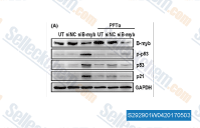
|
|
| S8059 | Nutlin-3a | Nutlin-3a ((-)-Nutlin-3), the active enantiomer of Nutlin-3, inhibits the p53/MDM2 interaction with IC50 of 90 nM in a cell-free assay. Nutlin-3a induces autophagy and apoptosis in a p53-dependent manner. |
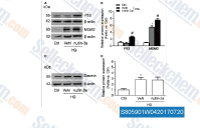
|
|
| S7030 | RG-7112 | RG7112 (RO5045337) is an orally bioavailable and selective p53-MDM2 inhibitor with HTRF IC50 of 18 nM. | ||
| S2930 | Pifithrin-μ | Pifithrin-μ (NSC 303580, PFTμ, 2-Phenylethynesulfonamide) is a specific p53 inhibitor by reducing its affinity to Bcl-xL and Bcl-2, and also inhibits HSP70 function and autophagy. |
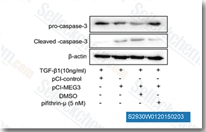
|
|
| S2341 | (-)-Parthenolide | (-)-Parthenolide, an inhibitor of the Nuclear Factor-κB Pathway, specifically depletes HDAC1 protein without affecting other class I/II HDACs; Also promotes the ubiquitination of MDM2 and activates p53 cellular functions. |
-Parthenolide-S234101W0220161110.gif)
|
|
| S7724 | Eprenetapopt (APR-246) | Eprenetapopt (APR-246, PRIMA-1MET) is a small organic molecule that has been shown to restore tumour-suppressor function primarily to mutant p53 and also to induce cell death in various cancer types. APR-246 induces apoptosis and autophagy. | ||
| S7649 | SAR405838 | MI-773 (SAR405838) is an orally available MDM2 antagonist with Ki of 0.88 nM. Phase 1. |

|
|
| S1172 | Serdemetan (JNJ-26854165) | Serdemetan (JNJ-26854165) acts as a HDM2 ubiquitin ligase antagonist and also induces early apoptosis in p53 wild-type cells, inhibits cellular proliferation followed by delayed apoptosis in the absence of functional p53. Phase 1. |
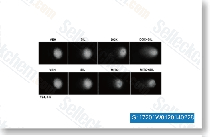
|
|
| S2781 | RITA | RITA induces both DNA-protein and DNA-DNA cross-links with no detectable DNA single-strand breaks, and also inhibits MDM2-p53 interaction by targeting p53. |
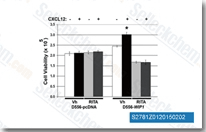
|
|
| S2678 | NSC 207895 | NSC 207895 (XI-006) suppresses MDMX with IC50 of 2.5 μM, leading to enhanced p53 stabilization/activation and DNA damage, and also regulates MDM2, an E3 ligase. |
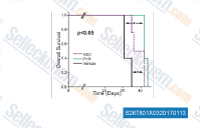
|
|
| S8483 | CBL0137 HCl | CBL0137 (CBLC137, Curaxin 137) HCl activates p53 and inhibits NF-κB with EC50s of 0.37 μM and 0.47 μM in the cell-based p53 and NF-kB reporter assays, respectively. It also inhibits histone chaperone FACT (facilitates chromatin transcription complex). | ||
| S0507 | CBL0137 | CBL0137 (Curaxin-137) is an inhibitor of the histone chaperone FACT (facilitates chromatin transcription) that simultaneously suppresses NF-κB and activates p53 with EC50 of 0.47 μM and 0.37 μM, respectively. | ||
| S7723 | PRIMA-1 | PRIMA-1 (2,2-Bis(hydroxymethyl)-3-quinuclidinone) is a mutant p53 reactivator. It induces apoptosis and inhibits growth of human tumors with mutant p53. | ||
| S8000 | Tenovin-1 | Tenovin-1 protects against MDM2-mediated p53 degradation, which involves ubiquitination, and acts through inhibition of protein-deacetylating activities of SirT1 and SirT2. Tenovin-1 is also an inhibitor of dihydroorotate dehydrogenase (DHODH). |
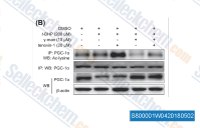
|
|
| S7149 | NSC 319726 (ZMC1) | NSC 319726 (ZMC1) is a p53(R175) mutant reactivator, exhibits growth inhibition in cells expressing mutant p53, with IC50 of 8 nM for p53(R175) mutant, shows no inhibition for p53 wild-type cells. | ||
| S4900 | Tenovin-6 | Tenovin-6 is a small molecule activator of p53 transcriptional activity and inhibits dihydroorotate dehydrogenase (DHODH). Tenovin-6 is also an inhibitor of SirT1 and SirT2. | ||
| S8149 | NSC348884 | NSC348884, as a nucleophosmin inhibitor, inhibit cell proliferation and induce apoptosis in various cancer cell lines with IC50 values ranging from 1.4-4 µM. | ||
| S8106 | NSC59984 | NSC59984 is a p53 pathway activator via induction of mutant p53 protein degradation and p73 activation. | ||
| S5791 | Cyclic Pifithrin-α hydrobromide | Cyclic Pifithrin-α hydrobromide is the hydrobromide salt form of Cyclic Pifithrin-α, which is a transcriptional inhibitor of p53. | ||
| S8580 | COTI-2 | COTI-2 is an orally available third generation thiosemicarbazone and activator of mutant forms of the p53 protein, with potential antineoplastic activity. | ||
| S5811 | Kevetrin hydrochloride | Kevetrin hydrochloride (Thioureidobutyronitrile) is a water-soluble, small molecule and activator of the tumor suppressor protein p53, with potential antineoplastic activity. | ||
| S8187 | ReACp53 | ReACp53 is a cell-penetrating peptide, designed to inhibit p53 amyloid formation, resues p53 function in cancer cell lines and in organoids derived from high-grade serous ovarian carcinomas (HGSOC). | ||
| F0523 | Lamin B1 Antibody [E7B10] | Lamin B1 Rabbit mAb recognizes endogenous levels of total Lamin B1 protein. | ||
| F2018 | p53 (acetyl Lys 370) Antibody [L18F8] | |||
| F0355 | Phospho-p53 (Ser15) Antibody [K22F18] | Phospho-p53 (Ser15) Mouse mAb detects endogenous levels of p53 only when phosphorylated at serine 15. The antibody does not cross-react with p53 phosphorylated at other sites. | ||
| F2931New | Phospho-p53 (Ser392) Antibody [E21F8] | p53 (phospho S392),Phospho-p53 (Ser392) | ||
| F0020New | p53 Antibody [F16A10] | |||
| F1148 | p63 Antibody [C16H5] | |||
| S9235 | Didymin | Didymin (Neoponcirin, Isosakuranetin-7-O-rutinoside) is a citrus-derived natural compound that kills p53 wild-type as well as drug-resistant p53-mutant neuroblastoma cells in culture. It possesses antioxidant, anti-inflammation and anti-cancer properties. | ||
| E1971 | Rezatapopt | Rezatapopt(PC14586) is a first-in-class p53 reactivator. It selectively binds to the mutated p53 Y220C protein and restores its wild-type activity. It can also be used to inhibit solid tumor with p53 mutation. | ||
| S2176 | Tenovin-3 | Tenovin-3 is an inhibitor of SIRT2. Tenovin-3 is able to increase p53 levels in MCF-7 cells. | ||
| E0935 | MS7972 | MS7972 is a small molecule that blocks human p53 and CREB binding protein association. | ||
| S6882 | HI-TOPK-032 | HI-TOPK-032 is a potent and specific inhibitor of TOPK. HI-TOPK-032 also reduces ERK-RSK phosphorylation, regulates of the abundance of p53, cleaved caspase-7, and cleaved PARP, and induces apoptosis in cancer cells. | ||
| E0068 | NiCur | NiCur is a small molecule which blocks CREB-binding protein (CBP) histone acetyltransferase (HAT) activity and downregulates p53 activation upon genotoxic stress and diminishs the recruitment of p53 as well as RNA Polymerase II and levels of acetylation on histone H3 on CDKN1A promoter. | ||
| E0394 | YK 3-237 | YK-3-237, a SIRT1 activator, reduces acetylation of mutant p53 and inhibits the proliferation of triple-negative breast cancer cells. | ||
| E2943 | Pifithrin-β | Pifithrin-β (PFT β hydrobromide; Cyclic Pifithrin-α hydrobromide) is a potent inhibitor of p53 with an IC50 of 23 μM and is regarded as a lead compound for cancer and neurodegenerative disease therapy. | ||
| E0035 | CP-31398 Dihydrochloride | CP-31398 Dihydrochloride stabilizes the active conformation of p53 and promotes p53 activity in cancer cell lines with mutant or wild-type p53. | ||
| E7154New | C16-Ceramide | C16-Ceramide (N-Palmitoylsphingosine)is a sphingolipid ligand and an activator of p53 tumor suppressor. It tightly binds within the p53 DNA-binding domain with a Kd of ~ 60 nM, in close vicinity to the Box V motif. It regulates the protein ubiquitination and proteasomal degradation and also induces apoptosis in cancer cells making it a research tool for targeting human cancers. | ||
| S6851 | RA-190 | RA190, a bis-benzylidine piperidon, is a potent, selective and oral effective inhibitor of proteasome ubiquitin receptor RPN13/ADRM1 with anticancer activity. RA190 triggers ER stress response, p53/p21 signaling axis and autophagy in multiple myeloma cells. | ||
| E1735 | PK11007 | PK11007 is a thiol-reactive anticancer agent that stabilizes p53 via selective alkylation of two surface cysteines without compromising its DNA binding. It induces mutant p53 cancer cell death by increasing reactive oxygen species (ROS) levels. | ||
| S9488 | Lobetyolin | Lobetyolin is one of the important active ingredients extracted from the root of Codonopsis pilosula, which has a good protective effect on gastric mucosal damage. Lobetyolin can downregulate glutamine metabolism, contribute to drug-induced apoptosis and tumor growth inhibition, and lobetyolin significantly reduces the mRNA and protein expression of the amino acid transporter alanine-serine-cysteine transporter 2 (ASCT2). | ||
| S8728 | PK11000 | PK11000 stabilizes the DBD of both WT and mutant p53 proteins by covalent cysteine modification without compromising DNA binding and is effective in inducing cell death. | ||
| S2427 | Triglycidyl Isocyanurate (Teroxirone) | Triglycidyl Isocyanurate (Teroxirone, Tris(2,3-epoxypropyl) Isocyanurate, TGI, TGIC) is a triazene triepoxide with antineoplastic activity. It inhibits growth of human non-small cell lung cancer cells by activating p53. Triglycidyl Isocyanurate alkylates and cross-links DNA, thereby inhibiting DNA replication. Triglycidyl Isocyanurate is also used in various polyester powder coatings in the metal finishing industry. | ||
| S2929 | Pifithrin-α (PFTα) Hhydrobromide | Pifithrin-α is an inhibitor of p53, inhibiting p53-dependent transactivation of p53-responsive genes. Pifithrin-α is also a potent agonist of the aryl hydrocarbon receptor (AhR). |

|
|
| S7030 | RG-7112 | RG7112 (RO5045337) is an orally bioavailable and selective p53-MDM2 inhibitor with HTRF IC50 of 18 nM. | ||
| S2930 | Pifithrin-μ | Pifithrin-μ (NSC 303580, PFTμ, 2-Phenylethynesulfonamide) is a specific p53 inhibitor by reducing its affinity to Bcl-xL and Bcl-2, and also inhibits HSP70 function and autophagy. |

|
|
| S5791 | Cyclic Pifithrin-α hydrobromide | Cyclic Pifithrin-α hydrobromide is the hydrobromide salt form of Cyclic Pifithrin-α, which is a transcriptional inhibitor of p53. | ||
| S8187 | ReACp53 | ReACp53 is a cell-penetrating peptide, designed to inhibit p53 amyloid formation, resues p53 function in cancer cell lines and in organoids derived from high-grade serous ovarian carcinomas (HGSOC). | ||
| F0020New | p53 Antibody [F16A10] | |||
| S9235 | Didymin | Didymin (Neoponcirin, Isosakuranetin-7-O-rutinoside) is a citrus-derived natural compound that kills p53 wild-type as well as drug-resistant p53-mutant neuroblastoma cells in culture. It possesses antioxidant, anti-inflammation and anti-cancer properties. | ||
| E0935 | MS7972 | MS7972 is a small molecule that blocks human p53 and CREB binding protein association. | ||
| E0068 | NiCur | NiCur is a small molecule which blocks CREB-binding protein (CBP) histone acetyltransferase (HAT) activity and downregulates p53 activation upon genotoxic stress and diminishs the recruitment of p53 as well as RNA Polymerase II and levels of acetylation on histone H3 on CDKN1A promoter. | ||
| E0394 | YK 3-237 | YK-3-237, a SIRT1 activator, reduces acetylation of mutant p53 and inhibits the proliferation of triple-negative breast cancer cells. | ||
| E2943 | Pifithrin-β | Pifithrin-β (PFT β hydrobromide; Cyclic Pifithrin-α hydrobromide) is a potent inhibitor of p53 with an IC50 of 23 μM and is regarded as a lead compound for cancer and neurodegenerative disease therapy. | ||
| E1735 | PK11007 | PK11007 is a thiol-reactive anticancer agent that stabilizes p53 via selective alkylation of two surface cysteines without compromising its DNA binding. It induces mutant p53 cancer cell death by increasing reactive oxygen species (ROS) levels. | ||
| S9488 | Lobetyolin | Lobetyolin is one of the important active ingredients extracted from the root of Codonopsis pilosula, which has a good protective effect on gastric mucosal damage. Lobetyolin can downregulate glutamine metabolism, contribute to drug-induced apoptosis and tumor growth inhibition, and lobetyolin significantly reduces the mRNA and protein expression of the amino acid transporter alanine-serine-cysteine transporter 2 (ASCT2). | ||
| S8059 | Nutlin-3a | Nutlin-3a ((-)-Nutlin-3), the active enantiomer of Nutlin-3, inhibits the p53/MDM2 interaction with IC50 of 90 nM in a cell-free assay. Nutlin-3a induces autophagy and apoptosis in a p53-dependent manner. |

|
|
| S2341 | (-)-Parthenolide | (-)-Parthenolide, an inhibitor of the Nuclear Factor-κB Pathway, specifically depletes HDAC1 protein without affecting other class I/II HDACs; Also promotes the ubiquitination of MDM2 and activates p53 cellular functions. |
-Parthenolide-S234101W0220161110.gif)
|
|
| S7724 | Eprenetapopt (APR-246) | Eprenetapopt (APR-246, PRIMA-1MET) is a small organic molecule that has been shown to restore tumour-suppressor function primarily to mutant p53 and also to induce cell death in various cancer types. APR-246 induces apoptosis and autophagy. | ||
| S7649 | SAR405838 | MI-773 (SAR405838) is an orally available MDM2 antagonist with Ki of 0.88 nM. Phase 1. |

|
|
| S1172 | Serdemetan (JNJ-26854165) | Serdemetan (JNJ-26854165) acts as a HDM2 ubiquitin ligase antagonist and also induces early apoptosis in p53 wild-type cells, inhibits cellular proliferation followed by delayed apoptosis in the absence of functional p53. Phase 1. |

|
|
| S2781 | RITA | RITA induces both DNA-protein and DNA-DNA cross-links with no detectable DNA single-strand breaks, and also inhibits MDM2-p53 interaction by targeting p53. |

|
|
| S2678 | NSC 207895 | NSC 207895 (XI-006) suppresses MDMX with IC50 of 2.5 μM, leading to enhanced p53 stabilization/activation and DNA damage, and also regulates MDM2, an E3 ligase. |

|
|
| S8483 | CBL0137 HCl | CBL0137 (CBLC137, Curaxin 137) HCl activates p53 and inhibits NF-κB with EC50s of 0.37 μM and 0.47 μM in the cell-based p53 and NF-kB reporter assays, respectively. It also inhibits histone chaperone FACT (facilitates chromatin transcription complex). | ||
| S0507 | CBL0137 | CBL0137 (Curaxin-137) is an inhibitor of the histone chaperone FACT (facilitates chromatin transcription) that simultaneously suppresses NF-κB and activates p53 with EC50 of 0.47 μM and 0.37 μM, respectively. | ||
| S7723 | PRIMA-1 | PRIMA-1 (2,2-Bis(hydroxymethyl)-3-quinuclidinone) is a mutant p53 reactivator. It induces apoptosis and inhibits growth of human tumors with mutant p53. | ||
| S8000 | Tenovin-1 | Tenovin-1 protects against MDM2-mediated p53 degradation, which involves ubiquitination, and acts through inhibition of protein-deacetylating activities of SirT1 and SirT2. Tenovin-1 is also an inhibitor of dihydroorotate dehydrogenase (DHODH). |

|
|
| S7149 | NSC 319726 (ZMC1) | NSC 319726 (ZMC1) is a p53(R175) mutant reactivator, exhibits growth inhibition in cells expressing mutant p53, with IC50 of 8 nM for p53(R175) mutant, shows no inhibition for p53 wild-type cells. | ||
| S4900 | Tenovin-6 | Tenovin-6 is a small molecule activator of p53 transcriptional activity and inhibits dihydroorotate dehydrogenase (DHODH). Tenovin-6 is also an inhibitor of SirT1 and SirT2. | ||
| S8149 | NSC348884 | NSC348884, as a nucleophosmin inhibitor, inhibit cell proliferation and induce apoptosis in various cancer cell lines with IC50 values ranging from 1.4-4 µM. | ||
| S8106 | NSC59984 | NSC59984 is a p53 pathway activator via induction of mutant p53 protein degradation and p73 activation. | ||
| S8580 | COTI-2 | COTI-2 is an orally available third generation thiosemicarbazone and activator of mutant forms of the p53 protein, with potential antineoplastic activity. | ||
| S5811 | Kevetrin hydrochloride | Kevetrin hydrochloride (Thioureidobutyronitrile) is a water-soluble, small molecule and activator of the tumor suppressor protein p53, with potential antineoplastic activity. | ||
| E1971 | Rezatapopt | Rezatapopt(PC14586) is a first-in-class p53 reactivator. It selectively binds to the mutated p53 Y220C protein and restores its wild-type activity. It can also be used to inhibit solid tumor with p53 mutation. | ||
| S2176 | Tenovin-3 | Tenovin-3 is an inhibitor of SIRT2. Tenovin-3 is able to increase p53 levels in MCF-7 cells. | ||
| E7154New | C16-Ceramide | C16-Ceramide (N-Palmitoylsphingosine)is a sphingolipid ligand and an activator of p53 tumor suppressor. It tightly binds within the p53 DNA-binding domain with a Kd of ~ 60 nM, in close vicinity to the Box V motif. It regulates the protein ubiquitination and proteasomal degradation and also induces apoptosis in cancer cells making it a research tool for targeting human cancers. | ||
| S2427 | Triglycidyl Isocyanurate (Teroxirone) | Triglycidyl Isocyanurate (Teroxirone, Tris(2,3-epoxypropyl) Isocyanurate, TGI, TGIC) is a triazene triepoxide with antineoplastic activity. It inhibits growth of human non-small cell lung cancer cells by activating p53. Triglycidyl Isocyanurate alkylates and cross-links DNA, thereby inhibiting DNA replication. Triglycidyl Isocyanurate is also used in various polyester powder coatings in the metal finishing industry. | ||
| S6882 | HI-TOPK-032 | HI-TOPK-032 is a potent and specific inhibitor of TOPK. HI-TOPK-032 also reduces ERK-RSK phosphorylation, regulates of the abundance of p53, cleaved caspase-7, and cleaved PARP, and induces apoptosis in cancer cells. | ||
| S6851 | RA-190 | RA190, a bis-benzylidine piperidon, is a potent, selective and oral effective inhibitor of proteasome ubiquitin receptor RPN13/ADRM1 with anticancer activity. RA190 triggers ER stress response, p53/p21 signaling axis and autophagy in multiple myeloma cells. | ||
| F2931New | Phospho-p53 (Ser392) Antibody [E21F8] | p53 (phospho S392),Phospho-p53 (Ser392) | ||
| F0020New | p53 Antibody [F16A10] | |||
| E7154New | C16-Ceramide | C16-Ceramide (N-Palmitoylsphingosine)is a sphingolipid ligand and an activator of p53 tumor suppressor. It tightly binds within the p53 DNA-binding domain with a Kd of ~ 60 nM, in close vicinity to the Box V motif. It regulates the protein ubiquitination and proteasomal degradation and also induces apoptosis in cancer cells making it a research tool for targeting human cancers. |
